
Which Pope is that?
How to identify them by their symbols on buildings and a short history of each pope ... plus an exploration of symbols, shields and madonella around Rome.
1. The Renaissance Popes
1417 - 1534
3. Papal Shields, Family
Crests and Madonella
found around Rome
The Renaissance Popes: 1534 -
Pope Paul III (1534–1549) Family: Farnese
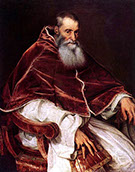
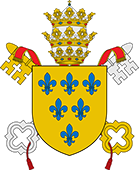 Born Alessandro Farnese, was head of the Catholic Church and ruler of the Papal States from 13 October 1534 to his death in 1549.
Born Alessandro Farnese, was head of the Catholic Church and ruler of the Papal States from 13 October 1534 to his death in 1549.
He came to the papal throne in an era following the sack of Rome in 1527 and rife with uncertainties in the Catholic Church following the Protestant Reformation. His pontificate initiated the Counter-Reformation with the Council of Trent in 1545, as well as the Wars of religion with Emperor Charles V's military campaigns against the Protestants in Germany. He recognized new Catholic religious orders and societies such as the Jesuits, the Barnabites, and the Congregation of the Oratory. His efforts were distracted by nepotism to advance the power and fortunes of his family, including his illegitimate son Pier Luigi Farnese.
Paul III was a significant patron of artists including Michelangelo, and it is to him that Nicolaus Copernicus dedicated his heliocentric treatise. Arguably the most significant artistic work produced during Paul's reign was the Last Judgement by Michelangelo in the Sistine Chapel of the Vatican Palace. Although the work was commissioned by Paul III's predecessor, Pope Clement VII, following the latter's death in 1534 Paul renewed the commission and oversaw its completion in 1541.
As a cardinal, Alessandro had begun construction of the Palazzo Farnese in central Rome, and its planned size and magnificence increased upon his election to the papacy. The palace was initially designed by the architect Antonio da Sangallo the Younger, received further architectural refinement from Michelangelo, and was completed by Giacomo della Porta. Like other Farnese family buildings, the imposing palace proclaims the family's power and wealth, similarly to Alessandro's Villa Farnese at Caprarola. In 1546, after the death of Sangallo, Paul appointed the elderly Michelangelo to take supervision of the building of St. Peter's Basilica. Paul also commissioned Michelangelo to paint the 'Crucifixion of St. Peter' and the 'Conversion of St. Paul' (1542–50), his last frescoes, in the Pauline Chapel of the Vatican.
Paul III's artistic and architectural commissions were numerous and varied. The Venetian artist Titian painted a portrait of the Pope in 1543, and in 1546, the well-known portrait of Paul III with his grandsons Cardinal Alessandro Farnese and Ottavio Farnese, Duke of Parma. Both are now in the Capodimonte Museum, Naples. The military fortifications in Rome and the Papal States were strengthened during his reign. He had Michelangelo relocate the ancient bronze of the Emperor Marcus Aurelius to the Capitoline Hill, where it became the centerpiece to the Piazza del Campidoglio.
Paul III's bronze tomb, executed by Guglielmo della Porta, is in St. Peter's.
Pope Julius III (1549-1555)
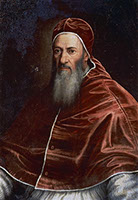
 Born Giovanni Maria Ciocchi del Monte, was head of the Catholic Church and ruler of the Papal States from 7 February 1550 to his death in 1555.
Born Giovanni Maria Ciocchi del Monte, was head of the Catholic Church and ruler of the Papal States from 7 February 1550 to his death in 1555.
After a career as a distinguished and effective diplomat, he was elected to the papacy as a compromise candidate after the death of Paul III. As pope he made only reluctant and short-lived attempts at reform, mostly devoting himself to a life of personal pleasure. His reputation, and that of the Catholic Church, were greatly harmed by his scandal-ridden relationship with his adopted nephew.
His nephew Innocenzo del Monte was a teenaged beggar found in the streets of Parma who was hired by the family as a lowly hall boy in their primary residence, the boy's age being variously given as 14, 15 or 17 years. After the elevation of Julius to the papacy, Innocenzo Del Monte was adopted into the family by the pope's brother and, by Julius, was then promptly created cardinal-nephew. Julius showered his favourite with benefices, including the commendatario of the abbeys of Mont Saint-Michel in Normandy and Saint Zeno in Verona, and, later, of the abbeys of Saint Saba, Miramondo, Grottaferrata and Frascati, among others. As rumours began to circle about the particular relationship between the pope and his adoptive nephew, Julius refused to take advice. The cardinals Reginald Pole and Giovanni Carafa warned the pope of the "evil suppositions to which the elevation of a fatherless young man would give rise".
The pope's lack of interest in political or ecclesiastical affairs caused dismay among his contemporaries. He spent the bulk of his time, and a great deal of papal money, on entertainments at the Villa Giulia, created for him by Vignola, but more significant and lasting was his patronage of the great Renaissance composer Giovanni Pierluigi da Palestrina, whom he brought to Rome as his maestro di cappella, Giorgio Vasari, who supervised the design of the Villa Giulia, and Michelangelo, who worked there.
Pope Marcellus II (1555-1555)
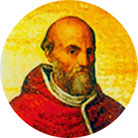
 Born Marcello Cervini degli Spannochi, was head of the Catholic Church and ruler of the Papal States from 9 April 1555 until his death 22 days later on 1 May 1555.
Born Marcello Cervini degli Spannochi, was head of the Catholic Church and ruler of the Papal States from 9 April 1555 until his death 22 days later on 1 May 1555.
He succeeded Pope Julius III. Before his accession as pope he had been Cardinal-Priest of Santa Croce in Gerusalemme. He is the most recent pope to choose to retain his birth name as his regnal name upon his accession, as well as only the second and most recent pope to date to take the name "Marcellus" upon being elected. After his death, it would be 423 years before another pope would choose a name with an ordinal number less than IV (John Paul I).
Cervini was the maternal uncle of Robert Bellarmine. Cervini's father and Pope Clement VII were personal friends. Cervini served in the household of Cardinal Alessandro Farnese. When Farnese became Pope, Cervini served as his secretary and was employed on some diplomatic missions. On April 10, 1555, he was elected to succeed Pope Julius III. He died of a stroke twenty-two days later.
Though Marcellus II desired to reform many of the inner workings of the church, his feeble constitution succumbed to the fatigues of the conclave, the exhausting ceremonies connected with his ascension, the anxieties arising from his high office, and overexertion in his performance of the pontifical functions of the Holy Week and Easter. He quickly fell ill.
He was bled, and appeared to begin to recover. In an audience he gave to the Cardinals, who wanted him to sign the Electoral Capitulations from the conclave and to guarantee that he would make no more cardinals than those agreements allowed, he refused to sign, stating that he would show his intent by deeds not words. In his first audience with the Ambassadors of France and Spain, he warned the Ambassadors that their monarchs should keep the peace that had been agreed upon, and that if they did not, not only would they be sent Nuncios and Legates, but that the Pope himself would come and admonish them. He wrote letters to the Emperor, to Queen Mary I of England, and to Cardinal Reginald Pole (in which he confirmed Pole's Legateship in England). When the Spanish Ambassador asked for pardon for having killed a man, the Pope replied that he did not want to start his reign with such auspices as absolution from homicide, and ordered the appropriate tribunals to observe the law.
He did not want his relatives descending on Rome, nor did he want them to be enriched beyond the station of a member of the nobility, and he did not allow his two nephews, Riccardo and Herennius (sons of his half-brother Alexander), who lived in Rome under his care, to have formal visits. He instituted immediate economies in Vatican expenditures. On 28 April, he was able to receive the Duke of Urbino in audience, and on 29 April, the Duke of Ferrara. He also gave audience to four cardinals, Farnese, D'Este, Louis de Guise and Ascanio Sforza, the leaders of the French faction in the recent conclave. That night he had difficulty sleeping. On the morning of the 30th he suffered a stroke and slipped into a coma. That night he died, on the 22nd day after his election.
Pope Paul IV (1555-1559)
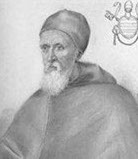
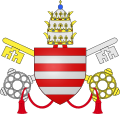 Born Gian Pietro Carafa, was head of the Catholic Church and ruler of the Papal States from 23 May 1555 to his death in 1559. While serving as papal nuncio in Spain, he developed an anti-Spanish outlook that later coloured his papacy. A part of Papal States was invaded by Spain during his papacy and in response to this, he called for a French military intervention. To avoid a conflict at the same time of the Italian War of 1551–1559, the Papacy and Spain reached a compromise with the Treaty of Cave: French and Spanish forces left the Papal States and the Pope adopted a neutral stance between France and Spain.
Born Gian Pietro Carafa, was head of the Catholic Church and ruler of the Papal States from 23 May 1555 to his death in 1559. While serving as papal nuncio in Spain, he developed an anti-Spanish outlook that later coloured his papacy. A part of Papal States was invaded by Spain during his papacy and in response to this, he called for a French military intervention. To avoid a conflict at the same time of the Italian War of 1551–1559, the Papacy and Spain reached a compromise with the Treaty of Cave: French and Spanish forces left the Papal States and the Pope adopted a neutral stance between France and Spain.
Carafa was appointed bishop of Chieti, but resigned in 1524 in order to found with St. Cajetan the Congregation of Clerics Regular (Theatines). Recalled to Rome and made Archbishop of Naples, he was instrumental in setting up the Roman Inquisition and was opposed to any dialogue with the emerging Protestant party in Europe. Carafa was elected pope in 1555 through the influence of Cardinal Alessandro Farnese in the face of opposition from Emperor Charles V. His papacy was characterized by strong nationalism in reaction to the influence of Philip II of Spain and the Habsburgs. He compelled the Jews of Rome to wear distinctive clothing and confine themselves to a ghetto. The appointment of Carlo Carafa as Cardinal Nephew damaged the papacy further when Paul was forced to remove him from office following a scandal. He curbed many clerical abuses in Rome, but his methods were seen as harsh.
As pope his nationalism was a driving force; he used the office to preserve some liberties in the face of fourfold foreign occupation. Like Pope Paul III, he was an enemy of the Colonna family. His treatment of Giovanna d'Aragona, who had married into that family, drew further negative comment from Venice. This because she had long been a patron of artists and writers.
As Cardinal-nephew, Carlo Carafa became his uncle's chief political adviser. Having accepted a pension from the French, Cardinal Carafa worked to secure a French alliance. Carlo's older brother Giovanni was made commander of the papal forces and Duke of Paliano after the pro-Spanish Colonna were deprived of that town in 1556. Another nephew, Antonio, was given command of the Papal guard and made Marquis of Montebello. Their conduct became notorious in Rome. However at the conclusion of the disastrous war with Philip II of Spain in the Italian War of 1551–59 and after many scandals, in 1559 the Pope publicly disgraced his nephews and banished them from Rome.
With the Protestant Reformation, the Papacy required all Roman Catholic rulers to consider Protestant rulers as heretics, thus making their realms illegitimate under customary international law. Consequently, Europe's Catholic monarchs considered Ireland a feudal fief of the Papacy, to be granted to any Catholic sovereign who managed to secure the recently-established Kingdom of Ireland from the control of its Protestant monarchs. Paul IV issued a papal bull in 1555, Ilius, per quem Reges regnant, recognising Philip and Mary as King and Queen of England and its dominions including Ireland. He also angered people in England by insisting on the restitution of property confiscated during the dissolution, and rejected the claim of Elizabeth I of England to the Crown.
Paul IV was violently opposed to the liberal Giovanni Cardinal Morone whom he strongly suspected of being a hidden Protestant, so much that he had him imprisoned. In order to prevent Morone from succeeding him and imposing what he believed to be his Protestant beliefs on the Church, Pope Paul IV codified the Catholic Law excluding heretics and non-Catholics from receiving or legitimately becoming Pope, in the bull Cum ex apostolatus officio.
Paul IV was rigidly orthodox, austere in life, and authoritarian in manner. He affirmed the Catholic doctrine of extra ecclesiam nulla salus ("Outside the Church there is no salvation"). He used the Holy Office to suppress the Spirituali, a Catholic group deemed heretical. The strengthening of the Inquisition continued under Paul IV, and few could consider themselves safe by virtue of position in his drive to reform the Church; even cardinals he disliked could be imprisoned. He appointed inquisitor Michele Ghislieri, the future Pope Pius V, to the position of Supreme Inquisitor despite the fact as Inquisitor of Como, Ghislieri's persecutions had inspired a citywide rebellion, forcing him to flee in fear of his life.
On 17 July 1555, Paul IV issued one of the most infamous papal bulls in Church history. The bull, Cum Nimis Absurdum (the title stemmed from its opening phrase, "Since it is absurd") ordered the creation of a Jewish ghetto in Rome. The pope set its borders near the Rione Sant'Angelo, an area where large numbers of Jews already resided, and ordered it walled off from the rest of the city. A single gate, locked every day at sundown, was the only means of reaching the rest of the city. The Jews themselves were forced to pay all design and construction costs related to the project, which came to a total of roughly 300 scudi. The bull restricted Jews in other ways as well. They were forbidden to have more than one synagogue per city, leading, in Rome alone, to the destruction of seven "excess" places of worship. All Jews were forced to wear distinctive yellow hats, especially outside the ghetto, and they were forbidden to trade in everything but food and secondhand clothes. Christians of all ages were encouraged to treat the Jews as second-class citizens; for a Jew to defy a Christian in any way was to invite severe punishment, often at the hands of a mob. By the end of Paul IV's five-year reign the number of Roman Jews had dropped by half. Yet his anti-semitic legacy endured for over 300 years: the ghetto he established ceased to exist only with the dissolution of the Papal States in 1870. Its walls were torn down in 1888.
According to Leopold von Ranke, a rigid austerity and an earnest zeal for the restoration of primitive habits became the dominant tendency of his Papacy. Monks who had left their monasteries were expelled from the city and from the Papal States. He would no longer tolerate the practice by which one man had been allowed to enjoy the revenues of an office while delegating its duties to another.
All begging was forbidden. Even the collection of alms for Masses, which had previously been made by the clergy, was discontinued. A medal was struck representing Christ driving the money changers from the Temple. Paul IV put in place a reform of the papal administration designed to stamp out trafficking of principal positions in the Curia. All secular offices, from the highest to the lowest, were assigned to others based on merit. Important economies were made and taxes were proportionately remitted. Paul IV established a chest, of which only he held the key, for the purpose of receiving all complaints that anyone desired to make.
During his papacy, censorship reached new heights. Among his first acts as Pope was to cut off Michelangelo's pension and he ordered the nudes of The Last Judgment in the Sistine Chapel be painted more modestly (a request that Michelangelo ignored), the beginning of the Vatican's Fig leaf campaign. Paul IV also introduced the Index Librorum Prohibitorum or "Index of Prohibited Books" to Venice, then an independent and prosperous trading state, in order to crack down on the growing threat of Protestantism. Under his authority, all books written by Protestants were banned, together with Italian and German translations of the Latin Bible.
Paul IV's health began to break down in May 1559. He rallied in July, holding public audiences and attending meetings of the Inquisition. But he engaged in fasting and the heat of the summer wore him down again. He was bedridden and on 17 August it became clear he would not live. Cardinals and other officials gathered at his bedside on 18 August, where Paul IV asked them to elect a "righteous and holy" successor and to retain the Inquisition as "the very basis" of the Catholic Church's power. By 2 or 3 PM, he was close to death, and died at 5 PM.
The people of Rome did not forget what they had suffered because of the war he had brought on the State. Crowds of people gathered at the Piazza del Campidoglio and began rioting even before Paul IV died. His statue, erected before the Campidoglio just months before, had a yellow hat placed on it, similar to the yellow hat Paul IV had forced Jews to wear in public. After a mock trial, the statue was decapitated. It was then thrown into the Tiber.
The crowd broke into the three city jails and freed more than 400 prisoners, then broke into the offices of the Inquisition at the Palazzo dell' Inquisizone near to the Church of San Rocco. They murdered the Inquisitor Tommaso Scotti and freed 72 prisoners. One of those released was Dominican John Craig, who later was a colleague of John Knox. The people ransacked the palace and then set it on fire, destroying the Inquisition's records. That same day, or the next day (records are unclear), the crowd attacked the Church of Santa Maria sopra Minerva. The intercession of some local nobility dissuaded them from burning it and killing all those within. On the third day of rioting, the crowd removed the Carafa family coat of arms from all churches, monuments and other buildings in the city.
Such hostile views have not mellowed much with time; modern historians tend to view his papacy as an especially poor one. His policies stemmed from personal prejudices—against Spain, for example, or the Jews—rather than any overarching political or religious goals. In a time of precarious balance between Catholic and Protestant, his adversarial nature did little to slow the latter's spread across northern Europe. His anti-Spanish feelings alienated the Habsburgs, arguably the most powerful Catholic rulers in Europe, and his ascetic personal beliefs left him out of touch with the artistic and intellectual movements of his era (he often spoke of whitewashing the Sistine Ceiling). Such a reactionary attitude alienated clergy and laity alike: historian John Julius Norwich calls him "the worst pope of the 16th century."
Four or five hours after his death, Paul IV's body was taken to the Cappella Paolina in the Apostolic Palace. It lay in repose and a choir sang the Office of the Dead on the morning of 19 August. Cardinals and many others then paid homage to Paul IV ("kissed the feet of the pope"). The canons of St. Peter's Basilica refused to take his body into the basilica unless they were paid the customary money and gifts. Instead, the canons sang the usual office in the Cappella del Santissimo Sacramento (Chapel of the Blessed Sacrament). Paul IV's body was taken to the Sistine Chapel in the Apostolic Palace at 6 PM.
Paul IV's nephew, Cardinal-nephew Carlo Carafa, arrived in Rome late on 19 August. Worried that the rioters might break in and desecrate the pope's corpse, at 10 PM Cardinal Carafa had Pope Paul IV buried without ceremony next to the Cappella del Volto Santo (Chapel of the Holy Face) in St. Peter's. His remains stayed there until October 1566, when his successor as pope, Pius V, had them transferred to Santa Maria sopra Minerva. In the chapel founded by Paul IV's uncle and mentor, Cardinal Oliviero Carafa, a tomb was created by Pirro Ligorio and Paul IV's remains placed therein.


